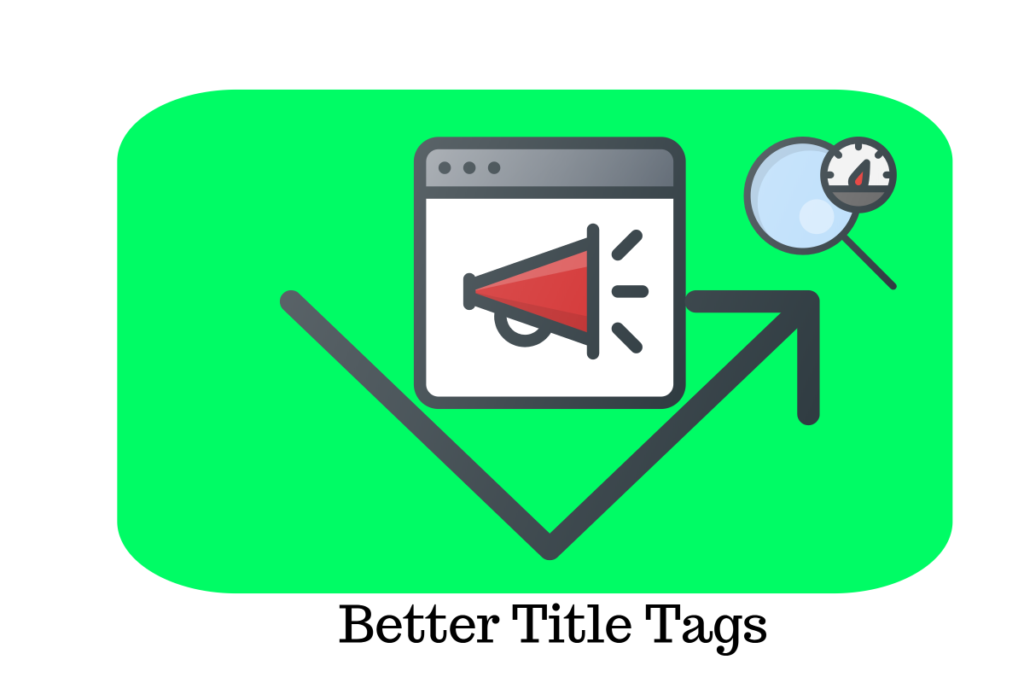Title tags are an important part of SEO and this comprehensive guide will explain everything you need to know to write the best titles for your pages and posts. It is comprehensive and will guide you through the different things to consider and the different ways choices you make for your title will impact your search ranking and your click-through rate.
It is a smart move if you are using WordPress to build a website that gets great SEO results. SEO is Search Engine Optimization and it means you are working regularly to rank well in Google, the number one search engine.
The title tag is the title of your WordPress page or post. It is very important because it helps you rank better if you use keywords in the beginning, and it also helps you attract clicks as people skim through the search results in the search engine.
It is usually the largest part of the search listing, highlighted for clicking and if you are on the first page of Google for a search, there is a good chance some of those search terms are in your title. That is good for ranking, but the closer your title matches someone’s search, the more likely they will click on it as well. So a good title tag is important all around.
Also, it is what appears in the tab of the browser. If someone is doing research, and they have multiple tabs open, a good title tag is more likely to draw them back into your site as part of their research. It is also the text that will be used for any bookmark or saving of the page. While not common for most pages, a good page that is an excellent resource that people want to refer back to often is very likely to be saved or bookmarked.
The title tag is also often the main part of the post whenever someone shares your page on social media. They will copy the link and then the system typically picks up your title tag, maybe a featured image and sometimes the metadata. The title will be very important for having people click on the link and visit your site, as well as making it more appealing to share in the first place.

All of these things make the title tag of your page or post very important. WordPress makes it very easy to write your title tag with little or no thought, but a good practice would be to write several title tags before picking one. Get familiar with the advantages and disadvantages of different title tag strategies in this document and write your title tag with purpose. If you are writing regularly in your WordPress site, you are going to get good SEO results. However, if you are sloppy with title tags, those results will be much lower.
Title Tag Rules for Success
Let’s look at some good and bad examples of title tags and how to make them better.
Title Tag Length – The length of your title tag should be 65-70 characters normally. The reason is that anything beyond that length will be cut off in your display in search engines. A cut-off title might look incomplete or less attractive to click on. Also, if you have more words, you dilute the power of your keywords, which should be in the first part of the title.

Keyword Stuffing – If you write your title tag just by stuffing keywords into it, then it is not going to be clicked on as often and when things get clicked on less, they often lose ranking because they are seen as more spammy and of less value. So instead of “Best Italian Restaurant Atlanta”, you can make it more readable and more interesting. “Atlanta’s Best Italian Restaurants According to Diners.”
Yes, the first option is probably better for an exact match to what people type, but the second title is much more likely to get clicks and seems like a real article, not just something written with keywords jammed in.
Localize Titles – There are many products and services which nationally it is simply too hard to rank for, but locally you can often quickly rank. This begins with a title tag being localized as well as the article itself. People are more likely to click on a product or service if it is clear that it serves people in their area.
So if you have an auto repair shop, “Best car repair” is terrible and “Best Car Repair in Dallas – Over 20 Years Experience” is great. This demonstrates localization of your title tag and by adding extensive experience, a searcher will be much more likely to want to at least check out your page.
Appending Company Name or Domain – There is a default option in many WordPress setups to put the company name or domain name at the end of the title. Whether this is a good idea of not depends on your company name and your targets. You do not want to lose space that you could use in a better title tag unless it gives you and the searcher value.

Let’s consider an example to better illustrate this. If you are a local landscaping business, having the word landscaping at the end of any title ads a good keyword. However, it depends on your company name. “JD Landscaping” is great to append. “The Smith Brothers Mowing and Landscaping” is too long and probably best not to append. Of course, it also depends on brand recognition and if a lot of people will recognize your name, then appending it might increase your chance of getting a click.
One positive is that if your company name gets cut off, that is not too bad. So in the end, it can work, but it does depend on the situation. Remember, you can always manually add it sometimes to titles instead of automatically append it to every page and post. “Spring Lawn Prep in Columbus with JD Landscaping”
Duplicate Titles – If you have two titles that are the same on your website, Google will usually only show one of them. That does not mean you cannot get two pages in the top ten of a search term, but they cannot be the same title. A common misconception is that duplicate titles or duplicate content gets a Google penalty, but in reality, it just gets filtered out and does not appear in search results. It does not hurt the site overall though.
The shame of having content filtered is that by having distinct titles and body content that is unique, you can rank twice. If you sell custom closet doors that people can install themselves, you could have two articles with titles like “DIY Custom Closet Doors – Get Them Delivered” and “Where to Order Custom Closet Doors and Save Money” While these are both similar topics, one might appeal more to someone than the other one, and if both articles are written well, both these titles would have a good chance to rank well for “Custom Closet Doors”
Negative Titles – Negative titles, just like negative subject lines in emails, often attract more attention and curiosity. The good news is that it is easy to use a negative title tag to still write an overall positive article. Remember, people might also be searching for negative reviews or comments about your company just to do good research, so controlling that search can be very valuable. Let’s say you own a salon in Portland named Elegant Style. What would be some negative title tags you could use to write positive articles?

- Bad Reviews of Elegant Style, a Portland Salon – This title could have an article about why the average rating for the salon is 4.5 and any time someone is unhappy, the salon does whatever it takes to make the situation right. This has the added advantage of targeting keywords like “Portland Salon” and the company name with review.
- Did the Portland Salon, Elegant Style, Go Out of Business? – No. We are still open (since whatever date) and we are going strong. Blah, blah, blah.
- Worst Haircuts in Portland – Must See Tragedies – This is an article with pictures of bad haircuts. Of course, you write about how none of these could ever happen at Elegant Styles.
These are just three examples but should give you food for thought on how to craft negative title tags that can be spun into a positive article overall. Keep in mind no one likes a pure bait and switch. That is where the headline says one thing and just completely does the opposite. So you would not want to have a title tag say “5 worst salons in Portland” and then the article is “We don’t know who the worst ones are, but we are great…..”
Instead, you could say “How to Spot a Bad Portland Salon” and then your article talks about ways to spot a bad salon, and contrast those items with how you run your salon in a professional manner. The difference is subtle, but important. No one likes to feel tricked.
Should You Change Title Tags for SEO?

If your website is doing well, but you think you can improve it by modifying title tags, here is our advice. First, look in Google Analytics at your page and see if it is getting good traffic. You do not want to mess with the title tag of a page or post if it is already pulling in good traffic. You can use a simple, free search volume tool like Keyword Surfer to see what the projected monthly volume is. It is a free chrome extension that helps you do fast research and assessments of traffic for your targets.

If you are highly ranked for the targeted keyword and you are not getting a lot of clicks, compared to the search volume, then you should definitely think about modifying a title tag to be more appealing for clicks, while still using the same basic keywords, and see how it changes the performance. It is a good idea to document the original title and the date and ranking when you make the change. Then circle back in a few weeks and see how things have changed. You can easily go back to the original title tag if it was performing better with ranking or clicks that way.
Sometimes you have a page that is OK, but you think a different title or different slant to the article would be better. If the article or page has some ranking and traffic, do not revamp the whole thing. Instead, you can write another version that is different but along the same lines.
Too often, site owners think that people are reading everything they have put out, and it is nowhere close to true. You do not want to publish the exact same topic over and over, but you can safely cycle back through the same topics regularly with some variance. For the title tags, this means you can have a couple of pages with different titles and approaches all targeting the same general keyword phrase.
If you just signed up with an SEO tool like Moz, for example, you will get warnings most likely about titles being too long. This is one area where you do not want to panic. Any title that is too long potentially can be shortened and improved, but long titles are not actually likely to hurt your SEO. They could impact clicks in the listings though if the title is too wordy or important parts are hidden after the first 65 characters of the title. Definitely review the list and fix those that you can, but do not worry about doing them first thing.
Technical Details of Title Tags
There are some technical issues you should be aware of, or review with your web manager, to make sure they are right. Typically out of the box the title tag is going to work fine, but sometimes custom installs, plugins or special themes can make things not work correctly.
- The title should be an H1 tag in the page
- <title> Metadata should match the same title unless it has added appending the business name
- URL is typically the same as the title, with common words removed and a dash in place of spaces www.domain.com/this-is-the-title (Example)
While there are many other technical elements of the page for good SEO, this is relevant specifically for how titles work in a well-optimized WordPress site. It also helps internal linking if the title is used any time there is a link to the page or post, instead of something like “Read More” or “Click Here”
The title is something you can write with little thought in a matter of a few seconds. But as you can see here, the title is very important in many areas and giving it serious thought and treatment can be the difference between single-digit organic traffic and thousands of clicks.

